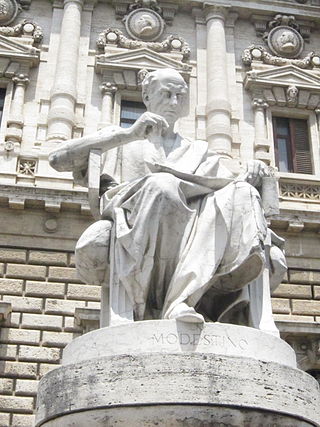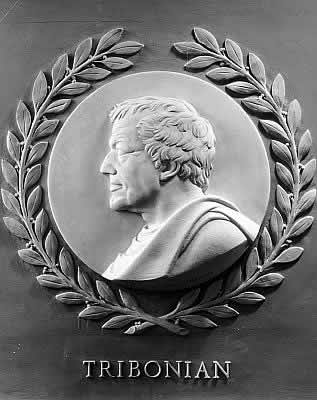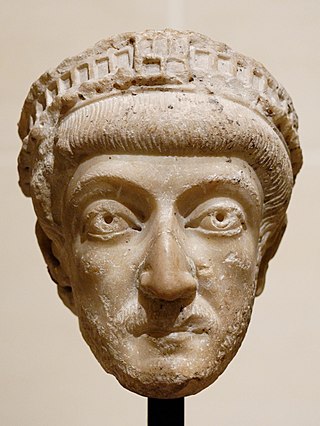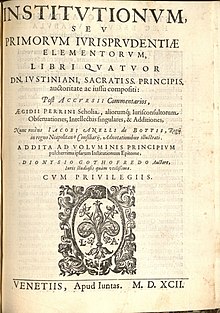
The Corpus JurisCivilis is the modern name for a collection of fundamental works in jurisprudence, issued from 529 to 534 by order of Byzantine Emperor Justinian I. It is also sometimes referred to metonymically after one of its parts, the Code of Justinian.

Herennius Modestinus, or simply Modestinus, was a civil servant and a celebrated Roman jurist, a student of Ulpian who flourished about 250 AD.

Tribonian was a Byzantine jurist and advisor. During the reign of the Emperor Justinian I, he supervised the revision of the legal code of the Byzantine Empire. He has been described as one of the wisest collaborators of Emperor Justinian.

The Digest, also known as the Pandects, was a compendium or digest of juristic writings on Roman law compiled by order of the Byzantine emperor Justinian I in 530–533 AD. It is divided into 50 books.

Gaius was a Roman jurist. Little is known about his personal life, including his name. It is also difficult to ascertain the span of his life, but it is assumed he lived from AD 110 to at least AD 179, as he wrote on legislation passed within that time.

The Codex Theodosianus was a compilation of the laws of the Roman Empire under the Christian emperors since 312. A commission was established by Emperor Theodosius II and his co-emperor Valentinian III on 26 March 429 and the compilation was published by a constitution of 15 February 438. It went into force in the eastern and western parts of the empire on 1 January 439. The original text of the codex is also found in the Breviary of Alaric, promulgated on 2 February 506.

Byzantine law was essentially a continuation of Roman law with increased Orthodox Christian and Hellenistic influence. Most sources define Byzantine law as the Roman legal traditions starting after the reign of Justinian I in the 6th century and ending with the Fall of Constantinople in the 15th century. Although future Byzantine codes and constitutions derived largely from Justinian's Corpus Juris Civilis, their main objectives were idealistic and ceremonial rather than practical. Following Hellenistic and Near-Eastern political systems, legislations were tools to idealize and display the sacred role and responsibility of the emperor as the holy monarch chosen by God and the incarnation of law "nómos émpsychos", thus having philosophical and religious purposes that idealized perfect Byzantine kingship.
Dorotheus was a professor of Roman law in the law school of Berytus in Phoenicia. While his date of birth is unknown, he must at least have died before 542. He was one of the three commissioners appointed by the Eastern Roman emperor Justinian I to draw up a book of Institutes, after the model of the Institutes of Gaius, which should serve as an introduction to the Digest already completed and promulgated on 16 December 533. His colleagues in this project were Tribonian and Theophilus; and their work was accomplished in 533 and they were all granted with the highest title quaestor sacri palatii illustris. Except for the first code of 7 April 529, Dorotheus participated in the compiling of all Justinian's codes, including the second edition of the Codex Constitutionum.
Marcus Porcius Cato Licinianus was son of Cato the Censor by his first wife Licinia, and thence called Licinianus, to distinguish him from his half-brother, Marcus Porcius Cato Salonianus, the son of Salonia. He was distinguished as a jurist.
Julius Paulus, often simply referred to as Paul in English, was one of the most influential and distinguished Roman jurists. He was also a praetorian prefect under the Roman Emperor Alexander Severus.
Lucius Octavius Cornelius Publius Salvius Iulianus Aemilianus, generally referred to as Salvius Julianus, or Julian the Jurist, or simply Julianus, was a well known and respected jurist, public official, and politician who served in the Roman imperial state. Of north African origin, he was active during the long reigns of the emperors Hadrian, Antoninus Pius, and Marcus Aurelius, as well as the shorter reign of Marcus Aurelius' first co-Emperor, Lucius Verus.
Fred Heinrich Blume, or Fred H. Blume, as he referred to himself, was a German-born American attorney and judge. He served as a justice of the Wyoming Supreme Court for 42 years, from 1922 to 1963, and by himself translated from Latin into English the Codex Justinianus and the Novels, two parts of the Corpus Juris Civilis.
The Novellae Constitutiones, or Justinian's Novels, are now considered one of the four major units of Roman law initiated by Roman emperor Justinian I in the course of his long reign. The other three pieces are: the Codex Justinianus, the Digest, and the Institutes. Justinian's quaestor Tribonian was primarily responsible for compiling these last three. Together, the four parts are known as the Corpus Juris Civilis. Whereas the Code, Digest, and Institutes were designed by Justinian as coherent works, the Novels are diverse laws enacted after 534 that never were officially compiled during his reign.
The Institutes is a beginners' textbook on Roman private law written around 161 CE by the classical Roman jurist Gaius. The Institutes are considered to be "by far the most influential elementary-systematic presentation of Roman private law in late antiquity, the Middle Ages and modern times". The content of the textbook was considered to be lost until 1816, when a manuscript of it − probably of the 5th century − was discovered.
Clyde Pharr was an American classics professor at Ohio Wesleyan University, Southwestern Presbyterian University, Vanderbilt University, and, finally, at the University of Texas at Austin.

Samuel Parsons Scott, known as S. P. Scott, was an American attorney, banker and scholar. He was born in Hillsboro, Ohio, where he received a classics-based education at the Hillsboro Academy; he went on to earn his A.B. degree from the Miami University in 1868, was elected to Phi Beta Kappa, and obtained his A.M. degree from the same institution the following year. Scott was licensed to practice law in 1868 and was an attorney for several years in Leavenworth, Kansas and in San Francisco, but he left the practice of law in 1875 to return to Hillsboro and the family banking business. Thereafter, he also traveled in Europe, studied, and wrote. Late in his life, he served for many years on the editorial staff of the American Bar Association's Comparative Law Bureau.

The law school of Berytus was a center for the study of Roman law in classical antiquity located in Berytus. It flourished under the patronage of the Roman emperors and functioned as the Roman Empire's preeminent center of jurisprudence until its destruction in AD 551.

The Code of Justinian is one part of the Corpus Juris Civilis, the codification of Roman law ordered early in the 6th century AD by Justinian I, who was Eastern Roman emperor in Constantinople. Two other units, the Digest and the Institutes, were created during his reign. The fourth part, the Novellae Constitutiones, was compiled unofficially after his death but is now also thought of as part of the Corpus Juris Civilis.










